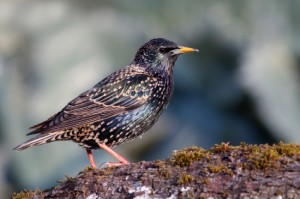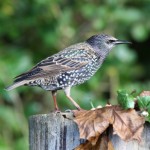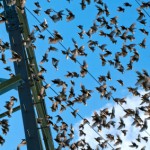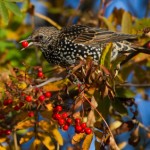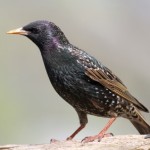Family, Description and Size:
Starlings are small passerine Birds that belong to the family of Sturnidae. They have strong feet and can fly over great distances. They are about 7.5 to 9.1 inches long and weigh on average about 2.0 to 3.6 oz. Their wing span ranges from 12 to 15 inches. Their plumage is black, with a green or purple gloss and white dots on its body.
Range and Habits:
The Common Starling was at first native to Europe and Asia, but it was introduced to North America, South America, Australia, Hawaii and other Pacific Islands, where it competes for space with the native birds and is considered an invasive species. This means that their introduction has caused an imbalance to the area’s fauna.
They love suburban and urban areas and also inhabit prairies and grasslands. They particularly like golf-fields, airports, city parks and other spaces within or close to cities that have trees to roost and nest on. They do not like dense and wet forests, but they have been found to live on the cliffs of coastal areas.
The Common Starling is insectivorous, which means it feeds mainly on insects. These include earthworms, moths, cicadas and spiders. While insects are the most important part of its diet the Starling
is also omnivorous and can eat fruit, grains seeds and nectar to complement its diet. Starlings often target agricultural areas, with large flocks causing a great deal of damage.
General Information:
The males create the nests and even ornament them with colorful flowers to attract a potential female mate. The male will sing during the construction of the nest and will do so even more when a female approaches to inspect. If she approves of his building skills she will accept to mate and lay eggs in his nest. Nest building might continue even during incubation.
Many nests can exist on the same tree and the birds will live communally, helping each other raise their young when possible. Starling also may flock together in huge numbers as they are a very gregarious species. The immense flocks are a spectacle to be seen, so many in number that they can darken the sky in some areas where many starlings gather.
This can spell destruction for a farm that might be close to such gatherings, as the Starlings will start feeding on the crops and seeds, ruining production. Flocks as large as 20,000 birds have been recorded; with some rural cities taking extraordinary measures to curtail their numbers.
Predators, Mortality and Lifespan:
The main predators of Starlings are humans. Raptors also prey on Starlings; but in Europe where Starlings are native, it is those protecting agriculture that have tried to lower their numbers, but have been unsuccessful and may never keep their numbers in check. In America the species poses a real pest problem, as they multiply immensely and create problems in airports, farms and cities. Their feces ruin structures in large cities, a negative trait that also causes concern. The Starling is on the least concern list of endangered animals and even though in Europe its numbers are declining, in America its numbers grow at a terrifying speed.
The oldest Starling ever recorded was 21 years old, but they usually live much shorter lives.

